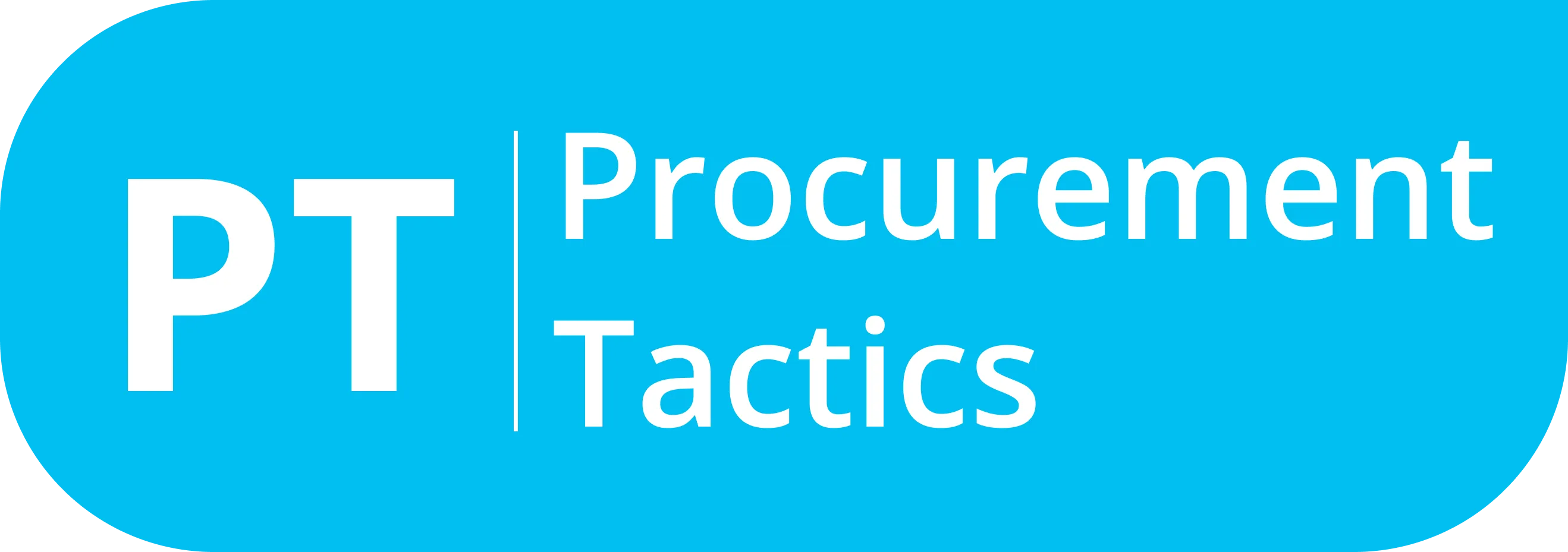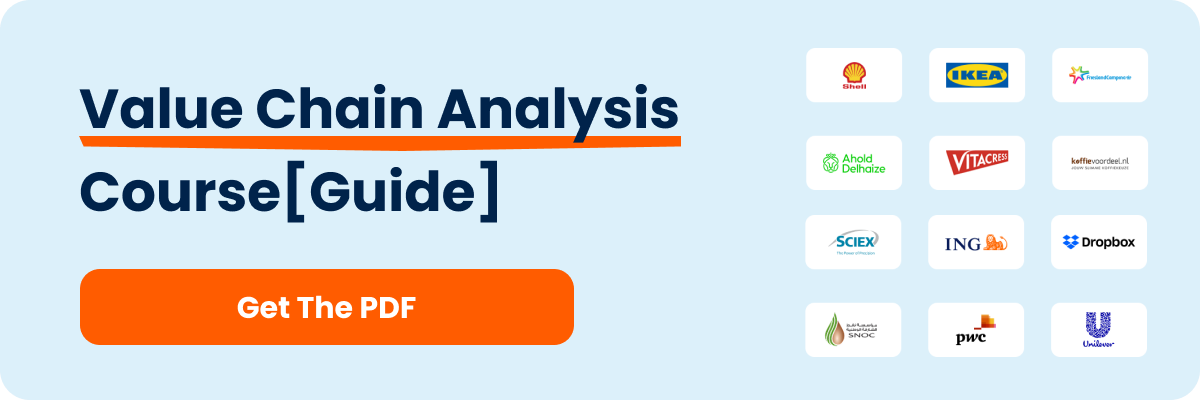Written by Marijn Overvest | Reviewed by Sjoerd Goedhart | Fact Checked by Ruud Emonds | Our editorial policy
Logistics and Procurement — The Relationship Explained

As taught in the Value Chain Analysis Course / ★★★★★ 4.9 rating
What is the relationship between logistics and procurement?
- Procurement secures the right products and services, while logistics ensures their efficient transportation, storage, and delivery.
- Effective coordination between procurement and logistics optimizes inventory management, reduces costs, and enhances supply chain efficiency.
- Both functions work together to mitigate supply chain risks, improve supplier reliability, and ensure timely fulfillment of business needs.
Logistics and Procurement Explained
Here, we will discuss logistics in procurement and their connection with each other.

Logistics in procurement refers to the systematic coordination and management of the flow of goods, information, and services from suppliers to consumers or other destinations. It plays a crucial role in optimizing the supply chain and ensuring the timely and cost-effective delivery of products.
The key elements of logistics in procurement include transportation, warehousing, inventory management, and distribution. Of course, having a warehouse to store supplies, as well as transportation to distribute said supplies is important. Inventory management is also needed to maintain product quality. This is why transportation, warehousing, inventory management, and distribution are all key elements of logistics and procurement.
With efficient logistics at hand, the organization enhances supply chain performance, reduces lead times, minimizes costs, and contributes to the overall effectiveness of the procurement process. Thus, integrating technology and strategic partnerships with logistics providers is now seen as essential for streamlining processes and improving the agility of procurement operations.
As an experienced procurement manager at Ahold Delhaize and Royal Friesland Campina, I have had extensive experience in making logistical arrangements in contracts. Logistics is a part of many standard contracts in FMCG. From a retailer’s perspective, you want to have as many things as possible stipulated. This mainly concerns service-level agreements where you want to be able to penalize suppliers for failing to deliver goods. From a supplier’s perspective, of course, you want to make as few agreements about this as possible
However, it is important to at least discuss objectives with each other. What are the key KPIs for both the supplier and the retailer and how can you collaborate to improve these KPIs?
Let’s first go back to some definitions. What are the differences between procurement, logistics, and supply chain?
What is Logistics?
Logistics refers to the process of planning efficient storage and transportation of goods from their origin to the point of destination.
But to keep it simple, logistics refers to the overall process of how goods are obtained, stored, and transported to their final destination. It optimizes the movement and storage of goods to ensure that it is delivered to the right place, at the right time, and in the right condition.
Ultimately, we must take note that logistics is just an element of the entirety of the supply chain. It is an aspect that is connected to both the supply chain and procurement.
But how is it connected to both the supply chain and procurement? Keep reading!
Logistics and Procurement – Example
Logistics and procurement are two essential functions in a company’s supply chain, working together to ensure efficient sourcing, transportation, and delivery of goods. Procurement focuses on acquiring the right products and services at optimal costs, while logistics ensures their timely movement and storage. Here are some real-life examples illustrating their connection:
1. Automotive Industry – Just-in-Time Manufacturing
Procurement Aspect: Toyota’s procurement team is responsible for sourcing critical auto parts such as engines, transmissions, and electronic components from global suppliers. They evaluate supplier reliability, negotiate contracts, and ensure compliance with quality and cost requirements.
Logistics Aspect: Once the parts are procured, logistics ensures they are delivered just in time (JIT) to Toyota’s assembly plants. This approach minimizes inventory costs and prevents excess stock while ensuring a seamless production flow. Logistics teams coordinate transportation, warehousing, and distribution to keep the supply chain running efficiently.
How these two aspects connect: If procurement fails to secure reliable suppliers or experiences contract issues, logistics will struggle to deliver materials on time, leading to production delays and costly disruptions. Similarly, if logistics faces transportation inefficiencies, even the best procurement strategy cannot prevent supply shortages or increased costs. The synchronization between procurement and logistics is critical for Toyota’s lean manufacturing success.
2. Retail Industry – Inventory Management in Supermarkets
Procurement Aspect: Walmart’s procurement team negotiates bulk purchases of groceries and household products from various suppliers to secure the best prices and ensure consistent stock availability. They establish supplier agreements, monitor product quality, and manage cost efficiency to maintain Walmart’s Everyday Low Prices strategy.
Logistics Aspect: After procurement secures the goods, logistics takes over by managing transportation, warehousing, and distribution. This ensures that fresh produce, dairy, and packaged foods are delivered to Walmart stores before they expire. Logistics teams coordinate cold chain management for perishable items and optimize inventory distribution to prevent overstocking or shortages.
How these two aspects connect: Efficient coordination between procurement and logistics is essential to prevent stockouts and minimize waste. If procurement fails to secure suppliers with consistent delivery schedules, logistics may struggle with late or unpredictable shipments, leading to empty shelves or spoilage.
On the other hand, if logistics cannot efficiently transport and store goods, procurement’s bulk buying strategy may result in excess inventory loss due to expiration. The seamless integration of procurement and logistics supports Walmart’s ability to offer affordable prices while ensuring product availability.
3. E-Commerce – Amazon’s Fulfillment Strategy
Procurement Aspect: Amazon’s procurement team secures deals with manufacturers and suppliers worldwide to source products sold on its platform. This includes negotiating bulk purchases, managing supplier relationships, and ensuring that products meet quality and cost standards. Procurement also ensures that high-demand items are consistently available to prevent stock shortages.
Logistics Aspect: Once products are sourced, logistics takes over by managing warehousing, inventory tracking, and last-mile delivery to customers. Amazon’s vast fulfillment centers store products efficiently, while advanced AI-driven inventory management ensures that stock is strategically distributed across locations to enable faster delivery times.
How these two aspects connect: Amazon’s Fulfillment by Amazon (FBA) program seamlessly integrates procurement and logistics. Procurement ensures a steady flow of inventory from global suppliers, while logistics optimizes storage, order fulfillment, and shipping.
If procurement fails to secure sufficient stock, logistics cannot meet delivery promises, impacting customer satisfaction. Conversely, if logistics is inefficient, even a well-structured procurement strategy would lead to delays, stock imbalances, and increased operational costs. The synergy between procurement and logistics is what enables Amazon’s rapid shipping and global supply chain efficiency.
4. Pharmaceutical Industry – Cold Chain Logistics
Procurement Aspect: Pfizer’s procurement team sources active pharmaceutical ingredients (APIs) and packaging materials from approved suppliers. These suppliers must meet strict regulatory and quality standards to ensure patient safety. Procurement also negotiates contracts and ensures that all raw materials comply with global health regulations, such as those set by the FDA and EMA.
Logistics Aspect: Since many medicines require temperature-controlled storage and transportation, logistics ensures that cold chain management is properly maintained throughout the supply chain. From supplier shipments to Pfizer’s manufacturing facilities, and then to hospitals and pharmacies, logistics teams coordinate specialized refrigerated transport and real-time monitoring to prevent temperature fluctuations that could compromise product efficacy.
How these two aspects connect: Effective coordination between procurement and logistics is critical to maintaining drug quality and compliance. If procurement fails to secure reliable suppliers who meet regulatory standards, logistics may struggle with inconsistent or non-compliant shipments.
On the other hand, if logistics mishandles temperature-sensitive pharmaceuticals, even the highest-quality ingredients sourced by procurement can become ineffective or unsafe for use. Poor coordination could result in product spoilage, costly recalls, or legal penalties. Seamless collaboration ensures that Pfizer’s medicines reach patients safely and efficiently.
In all these cases, logistics and procurement are interconnected, ensuring that businesses operate smoothly by securing the right products and delivering them efficiently. Without a strong procurement strategy, logistics would lack the necessary materials to transport. Conversely, without effective logistics, procurement efforts would be wasted due to inefficiencies in storage and distribution.
Logistics, Procurement, and Supply Chain: Compared
Logistics, supply chain, and procurement are all interconnected aspects of the process of acquiring and distributing goods or services, but they represent different stages and functions within that process. Let’s find out these differences.
In summary, procurement focuses on sourcing and acquiring goods or services, logistics focuses on the physical movement and storage of those goods, and supply chain management encompasses the broader coordination and optimization of all activities involved in delivering products or services to customers.
These three are interconnected in a way that all processes significantly contribute to the overall acquisition and delivery of goods, from sourcing and acquiring goods to delivering the goods, and the coordination of all the activities.
Logistics and Procurement Processes Explained
Here are the processes in procurement logistics that we’ve listed down for you.

1. Product policy
Product policy is concerned with defining the details of the product being built. This includes manufacturing details, warehousing considerations, and packaging materials.
2. Terms and conditions
Terms and conditions focus on the qualities of a provider that you will choose. This is where you can assess the provider of procurement logistics.
You can ask questions to yourself like does it offer auditing services or does it have access to additional resources?
This will allow you to access a faster transit lane for imports, making your supply chain productive. You must take note that the terms and conditions are laid out during the negotiation of the contract.
3. Communications strategy
Communication strategy is part of procurement logistics and how a company determines to make a product available.
It is the strategy that will decide if it will include multiple factories, regional distribution centers, and lengthy marketing advertisements in making the product available.
To keep it simple, it requires the materials from procurement to create a product that is readily available to all business-to-business partners and consumers.
Communication strategy is critical to the success or failure of new or upcoming products.
4. Purchasing strategy
The purchasing strategy is the part of procurement logistics that decides how a company will obtain the materials needed for manufacturing.
A good purchasing strategy entails collecting materials from various suppliers and analyzing the current trends in the market. It selects the best way to acquire materials at the lowest prices without compromising the quality.
The purchasing strategy keeps the competition alive and keeps prices from increasing.
Procurement Expert’s Advice on Logistics in Procurement
For this article, we asked a seasoned procurement professional to share his insights about logistics in procurement.
Sjoerd Goedhart
Owner, Goedhart Interim Management & Consultancy
LinkedIn Profile: https://www.linkedin.com/in/sjoerdgoedhart/
1. Can you share a personal example about logistics in procurement? What can readers learn from this?
“As a buyer of high-rotating food products for a retailer, it’s important to negotiate the logistics terms in the total proposal of procurement conditions and with RFQs to have this included.
This is to be sure that a supplier is willing to meet the delivery conditions and frequency (multiple DCs and frequency per week) to avoid out-of-stock and minimize the risk of this.
This also prevents additional costs from having to be incurred by one of the parties because the logistics conditions have not been coordinated. Ultimately, this affects the margin and any future willingness to collaborate or expand the collaboration. Therefore puts pressure on the relationship.”
Follow-up Question: How do you typically approach negotiations with suppliers regarding logistics terms?
“In negotiations with suppliers regarding logistics terms, it’s essential to outline key performance indicators (KPIs) and the associated consequences for not meeting them. This sets clear expectations from the outset.
Larger companies often have stringent logistics terms and service level agreements, which suppliers must accept to do business. Introducing these terms early in negotiations allows both parties to assess compatibility efficiently.
Even for smaller companies, consolidating logistics terms across suppliers reduces hidden costs and streamlines operations. This upfront clarity benefits all parties involved and can save significant resources in the long run.“
2. What should readers know about the logistics in procurement?
“Procurement logistics is the sourcing of materials needed to manufacture products. In other words, this part of the supply chain focuses on purchasing raw materials, replacement parts, auxiliary supplies, operating supplies, and other items needed for the manufacturing process.
Logistics plays a crucial role in an optimal procurement and supply chain process. Logistics and procurement are closely linked and, if optimally coordinated, can yield significant cost benefits.”
Follow-up Question: In what ways do logistics and procurement collaborate to optimize the supply chain process?
“Logistics and procurement collaborate through shared KPIs. Procurement should engage with logistics early in the process for optimal supply chain optimization.”
3. What is the biggest misconception about logistics in procurement? What do most people get wrong about this topic?
“One of them is that logistics is just about shipping and transportation. This is not correct. Effective logistics management involves coordinating all of the elements to ensure that goods are delivered to the right place, at the right time, and at the right cost“
4. How does logistics play a critical role in the success of procurement operations?
“An optimal logistics flow ensures an efficient production process because goods are available on time, limits inventories and shortens the storage lead time. All this ensures an efficient supply chain and delivers significant cost benefits for companies.“
5. What are the emerging trends in logistics that are impacting procurement strategies?
“There are various key trends that are transforming the industry:
- Digitalization and automation are streamlining operations
- Big data and predictive analytics are optimizing supply chain performance
- Agility in the supply chain
- Increasing consumption
- Rising e-commerce and ongoing reconfiguration of the supply chain to move goods more quickly and efficiently
- Sustainability and environmental responsibility“
6. Is logistics solely concerned with delivering goods, or does it involve additional aspects?
“No, it concerned much more than just the delivery of goods. It is the total process of getting the goods, transport, storage, and the most optimal mode of transport until timely delivery to the user.”
7. What skills should a procurement professional possess to be effective in logistics?
“A procurement professional in logistics should possess strong analytical and problem-solving skills for data analysis and decision-making. Additionally, excellent communication and negotiation skills are essential.“
Conclusion
Logistics in procurement provides a systematic management of the flow of goods and services from suppliers while ensuring the timely and cost-effective delivery of products. Thus, it maintains a smooth flow of purchasing, delivery, and everything in between.
While procurement is solely in charge of acquiring goods, logistics functions stretch further. So, when combined, logistics in procurement also oversees the proper delivery of goods and services to consumers or any other destination.
Moreover, there is a tedious process to procurement logistics. It has a step-by-step process that is crucial for you to follow to reach an optimal flow of your procurement process, and ultimately your supply chain.
After reading the article, I have created a free-to-download editable sourcing calendar template. It’s a PowerPoint file, together with an Excel file, that can help you streamline your logistic process from start to finish. I even created a video where I’ll explain how you can use this template.
Frequentlyasked questions
How do procurement and logistics work together?
Procurement sources and acquires goods, while logistics ensures their efficient transportation and delivery. Strong coordination prevents delays, stock shortages, and extra costs, improving overall supply chain performance.
What is logistics?
Logistics is a component of the supply chain that is concerned with the storage and movement of goods.
What is the difference between procurement and logistics?
To put this simply, procurement is the buying of goods or services. On the other hand, logistics is concerned primarily with the storage and movement of goods.
About the author
My name is Marijn Overvest, I’m the founder of Procurement Tactics. I have a deep passion for procurement, and I’ve upskilled over 200 procurement teams from all over the world. When I’m not working, I love running and cycling.







